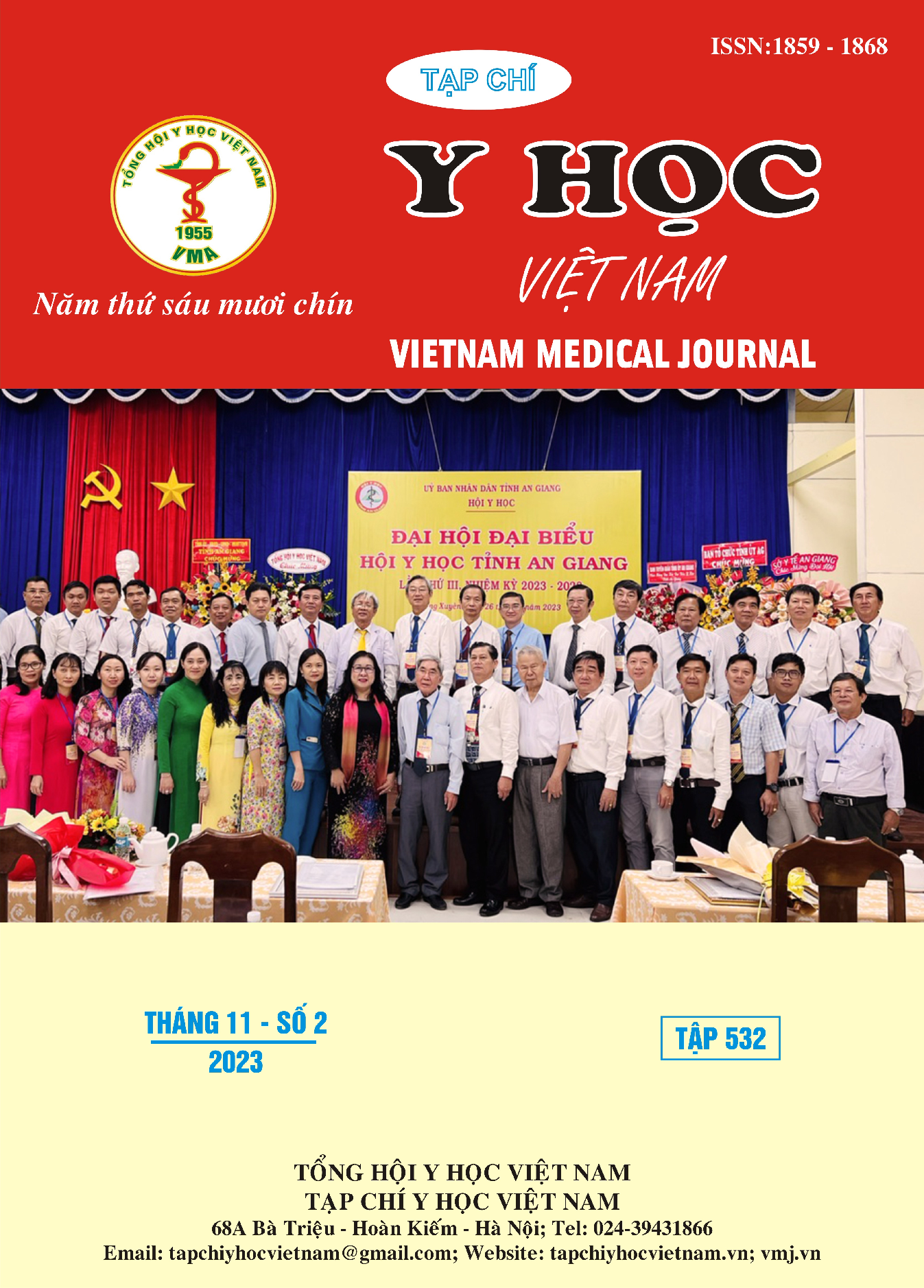ĐÁNH GIÁ HIỆU QUẢ CỦA PHƯƠNG PHÁP “TỰ QUẢN LÝ ĐAU” Ở BỆNH NHÂN ĐAU THẮT LƯNG MẠN TÍNH DO THOÁT VỊ ĐĨA ĐỆM
Nội dung chính của bài viết
Tóm tắt
Mục tiêu: Bước đầu đánh giá kết quả của
phương pháp “Tự quản lý đau” (Pain Self Management
- PSM) trong điều trị đau thắt lưng mạn tính ở bệnh nhân (BN) thoát vị đĩa đệm (TVĐĐ). Phương pháp nghiên cứu: Nghiên cứu can thiệp, có đối chứng, theo dõi dọc kết hợp hồi cứu và tiến cứu trên 82 BN đau thắt lưng mạn tính do TVĐĐ, điều trị nội trú tại khoa Thần kinh Bệnh viện Quân y 103 từ tháng 9/2022 đến tháng 5/2023; chia làm 2 nhóm: nhóm nghiên cứu (NC) gồm 41 BN được điều trị nội khoa cơ bản kết hợp với phương pháp “Tự quản lý đau” và nhóm chứng gồm 41 BN được điều trị nội khoa cơ bản đơn thuần. Kết quả: Sau điều trị, hiệu số điểm VAS ở nhóm NC là 5,17 ± 1,2 còn ở nhóm chứng là 4,17 ± 1,18 (p<0,05); hiệu số điểm OSWESTRY ở nhóm NC là 50,0 ± 10,1 còn ở nhóm chứng là 32,0 ± 16,2 (p < 0,05); hiệu số điểm ZUNG ở nhóm NC là 17,9 ± 4,2 còn ở nhóm chứng là 7,6 ± 5,6 (p< 0,05). Kết luận: Bước đầu đánh giá phương pháp “tự quản lý đau” có hiệu quả hỗ trợ điều trị nội khoa trong cải thiện mức độ đau, tình trạng mất chức năng của cột sống thắt lưng và triệu chứng rối loạn lo âu đối với BN đau thắt lưng mạn tính do TVĐĐ.
Chi tiết bài viết
Từ khóa
thoát vị đĩa đệm, đau thắt lưng mạn tính, tự quản lý đau
Tài liệu tham khảo
1. Nguyễn Văn Chương, Nghiên cứu thoát vị đĩa
đệm cột sống thắt lưng tại bộ môn - khoa Nội thần kinh, Bệnh viện 103 - Học viện Quân Y: Số liệu thu thập trong 10 năm gần đây (2004 - 2013) với 4718 bệnh nhân. Tạp chí Y dược học Quân sự 2015. 3: p. 5-16.
2. National Guideline Centre UK, Low back pain and sciatica in over 16s: assessment and management. 2016.
3. Vijan, S., S. Manaker, and A. Qaseem, Noninvasive treatments for acute, subacute, and chronic low back pain. Annals of Internal Medicine, 2017. 167(11): p. 835-836.
4. Hooff, M.L.v., et al., Daily functioning and self- management in patients with chronic low back pain after an intensive cognitive behavioral programme for pain management. 2010. 19: p. 1517-1526.
5. H. S. Chhabra, Sunil Sharma, and Shalini Verma, Smartphone app in self-management of chronic low back pain: a randomized controlled trial. European Spine Journal, 2018. 27(11): p. 2862-2874.
6. Mary Ersek, Results of a randomized controlled trial to examine the efficacy of a chronic pain self- management group for older adults [ISRCTN11899548]. 2008. 138(1): p. 29-40.
7. Ganji, R., et al., The Effect of Self-Management Educational Program on Pain Intensity in Elderly Patients with Knee Osteoarthritis: A Randomized Clinical Trial. Open Access Maced J Med Sci, 2018. 6(6): p. 1062-1066.
8. O. Hägg, P. Fritzell, and A. Nordwall, The clinical importance of changes in outcome scores after treatment for chronic low back pain. European Spine Journal, 2003. 12(1): p. 12-20.
đệm cột sống thắt lưng tại bộ môn - khoa Nội thần kinh, Bệnh viện 103 - Học viện Quân Y: Số liệu thu thập trong 10 năm gần đây (2004 - 2013) với 4718 bệnh nhân. Tạp chí Y dược học Quân sự 2015. 3: p. 5-16.
2. National Guideline Centre UK, Low back pain and sciatica in over 16s: assessment and management. 2016.
3. Vijan, S., S. Manaker, and A. Qaseem, Noninvasive treatments for acute, subacute, and chronic low back pain. Annals of Internal Medicine, 2017. 167(11): p. 835-836.
4. Hooff, M.L.v., et al., Daily functioning and self- management in patients with chronic low back pain after an intensive cognitive behavioral programme for pain management. 2010. 19: p. 1517-1526.
5. H. S. Chhabra, Sunil Sharma, and Shalini Verma, Smartphone app in self-management of chronic low back pain: a randomized controlled trial. European Spine Journal, 2018. 27(11): p. 2862-2874.
6. Mary Ersek, Results of a randomized controlled trial to examine the efficacy of a chronic pain self- management group for older adults [ISRCTN11899548]. 2008. 138(1): p. 29-40.
7. Ganji, R., et al., The Effect of Self-Management Educational Program on Pain Intensity in Elderly Patients with Knee Osteoarthritis: A Randomized Clinical Trial. Open Access Maced J Med Sci, 2018. 6(6): p. 1062-1066.
8. O. Hägg, P. Fritzell, and A. Nordwall, The clinical importance of changes in outcome scores after treatment for chronic low back pain. European Spine Journal, 2003. 12(1): p. 12-20.


